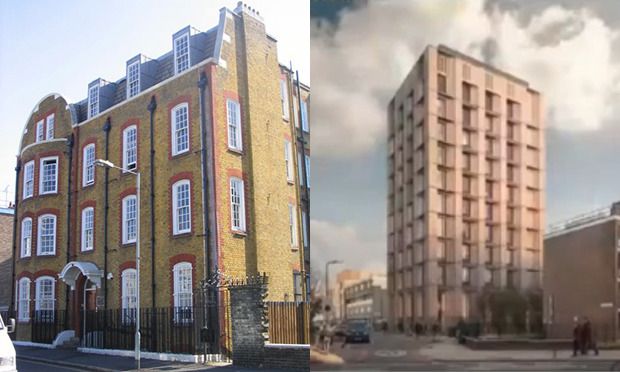Councillors split over demolition of former Royal Chest Hospital’s ‘last remnant’

Thoresby House, the 120-year-old “last remnant” of the Royal Chest Hospital and currently used as student housing, is to be demolished to make way for a 12-storey, purpose-built block.
The decision not only divided councillors on Hackney’s planning committee, but had neighbours warning that the new block on City Road would overshadow their homes and increase late-night antisocial behaviour, with the amount of students living there set to quadruple.
A petition circulated among immediate neighbours garnered 40 signatures in opposition to the proposals, with local resident Simon Hargreaves criticising the scale of change seen in the vicinity in recent years.
Hargreaves said: “It’s just non-stop. If you look at the amount of buildings that have gone up around here, it’s crazy.
“People who come to visit who I haven’t seen for a while say, ‘What the hell? I don’t recognise the place anymore’.
“This one is literally right behind the house now. It doesn’t benefit us in any way, really.”
According to Arcadia University, which owns Thoresby, all options to retain the existing building were found to be financially unviable, with representatives of the institution pointing to balancing measures including the provision of a room to rent for the community in the building, as well as the retention of the original’s foundation stone and gate.
The university also pointed to the fact that English Heritage had declined to list the building, as well as arguing that the new 12-storey block will allow Arcadia to better manage the site.
Speaking on behalf of residents, Cllr Yvonne Maxwell said: “I would like to highlight the value of what we will lose with proposed development and whether there is still demand for it. The Hackney Society has pointed out that the existing building is the last remnant of the Royal Chest Hospital, and it has been regarded as an undesignated heritage asset.
“We have seen the importance of stronger communities being built during Covid. Officers state that the site already provides student accommodation so there will be no new impacts, but how can a large building not impact on the area and its character?
“This building is right next to a nearby estate and its communal spaces. This would encroach onto the residential area and be out of keeping. How can four times the number of students not make new impacts? We are going from 33 students to 140 in a small residential area.
“The report says Arcadia would encourage students to consider local residents, but I hear examples where this doesn’t happen at present, with only 33 students.”
According to research carried out by residents and presented to the council, Thoresby House was constructed as a nurses’ home in 1900 for the Royal Chest Hospital, which was badly damaged by a bomb in the Blitz in 1941, but the home was left intact.
The hospital was Europe’s first specialist chest hospital, had Queen Victoria as its patron, and was also closely linked to pioneering female doctor Norah
Schuste, the first woman doctor to be permanently appointed at the Manchester Royal Infirmary when such appointments were generally restricted to men.
Schuster worked as a pathologist at the hospital between 1927 and 1954, the council was told, with several references to the nurses’ home (now Thoresby House) found in her papers in the London Metropolitan archives.
Cllr Katie Hanson, who voted against the plans, said that she was “not completely convinced” that the benefits of the 12-storey block outweighed the loss of the current Thoresby House.
Committee chair Cllr Vincent Stops said: “In terms of student numbers, we are providing accommodation for students. If we don’t, they will go and live in three-bedroom terraced houses, or council estates, or what have you. It does make a contribution towards our overall requirement for accommodation.
“I think it is sad that we are losing it, but the undesignated nature of this development means the protection is not strong. We would have to have a very strong reason to think that this would be viable to try and resist the loss of this building.”
Russell Peplow, director of operations at Arcadia, said: “Increasingly, we find our UK partners unable to guarantee accommodation for our students. We have owned and housed students at Thoresby House since the late 1990s, and during this time, we have explored a number of options to improve the standard of accommodation and extend the existing building to better meet the needs of our students and staff.
“Key issues with the existing building include a lack of disabled access, small and varying room sizes, a lack of communal space, and poor energy efficiency. All of the options we reviewed were found to be financially unviable, so in 2016 we started discussions [with the council] to explore options for the redevelopment of the site.
“During three years of discussions, the height of the building was reduced significantly, the layout and architecture was amended and refined. The university feels that the scheme is of the highest architectural quality and will provide our students and staff with well-designed, safe, accessible and comfortable accommodation during their stays in London.”
